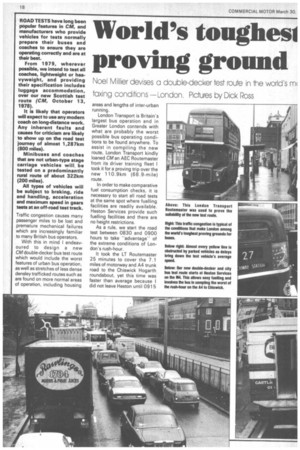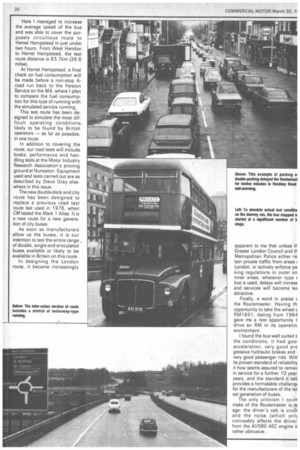World's toughesi proving ground
Page 20

Page 21

Page 22

If you've noticed an error in this article please click here to report it so we can fix it.
Noel V illier devises a double-decker test route in e word's mc taxing conditions —London. Pictures by Dick Ross
ROAD TESTS have long been popular features in CM, and manufacturers who provide vehicles for tests normally prepare their buses and coaches to ensure they are operating correctly and are at their best.
From 1979, wherever possible, we intend to test all coaches, lightweight or heavyweight, and providing their specification includes luggage accommodation, over our new Scottish test route (CM, October 13, 1978).
It is likely that operators will expect to use any modern coach on long-distance work. Any inherent faults and causes for criticism are likely to show up on the road test journey of almost 1,287km (800 miles).
Minibuses and coaches that are not urban-type stage carriage vehicles will, be tested on a predominantly rural route of about 322km (200 miles).
All types of vehicles will be subject to braking, ride and handling, acceleration and maximum speed in gears Jests at an off-road test track.
Traffic congestion causes many passenger miles to be lost and premature mechanical failures which are increasingly familiar to many British bus operators.
With this in mind I endeavoured to design a new CM double-decker bus test route which would include the worst features of urban bus operation, as well as stretches of less dense densley trafficked routes such as are found on more normal areas of operation, including housing
areas and lengths of inter-urban running.
London Transport is Britain's largest bus operation and in Greater London contends with what are probably the worst possible bus operating conditions to be found anywhere. To assist in compiling the new route, London Transport kindly loaned CM an AEC Routemaster from its driver training fleet I took it for a proving trip over the new 110.9km (68.9-mile) route.
In order to make comparative fuel consumption checks, it is necessary to start all road tests at the same spot where fuelling facilities are readily available. Heston Services provide such fuelling facilities and there are no height restrictions.
As a rule, we start the road test between 0830 and 0900 hours to take "advantage" of the extreme conditions of London's rush-hour.
It took the LT Routemaster 25 minutes to cover the 7.1 miles of motorway and A4 trunk road to the Chiswick Hogarth roundabout, yet this time was faster than average because I did not leave Heston until 091 5 hours, about one hour 'after the rush-hour peak.
At Hogarth roundabout, the test route leaves the trunk road and, via a couple of fairly sharp bends, joins the traffic queues on Chiswick High Road. Passenger demand dictates that many of LT's routes radiate into London via this route.
On the "dummyrun with the Routemaster, it became appa7mt that the major cause of traffic congestion was illegally parked cars and vans reducing road space and aggravating delays. One-way traffic systems on this route require some fairly sharp turns before reaching Hammersmith Broadway.
To simulate service running speeds and to gain as represen tative fuel consumption figures as possible for our road-test route, I plan to stop and start at about one-third of all bus stops. In the Routemaster it took 40 minutes to cover the 8 miles from Heston to Hammersmith Broadway.
From Hammersmith the route goes on towards the West End of London along Kensington High Street. On bus road tests, I plan not to use bus lanes as I do not intend to slow down genuine service buses or break the law. From the cab of the Routemaster it became very apparent to me that where there are bus lanes, many car drivers ignore them and, again, illegal parking causes major delay to bus services.
From Kensington High Street, the route rejoins the A4 at Knightsbridge, circumnavigates Hyde Park Corner where public transport has to bully it through a sea of traffic to get to Piccadilly — total journey time with the Routemaster so far — one hour, six minutes for 12-13 miles. This does not allow for time normally taken by passengers setting on and off.
From Piccadilly, the test route bends around Piccadilly Circus, down the Haymarket to Trafalgar Square. On our dummy run, traffic was remarkably light around Trafalgar Square, where the route turns north into Charing Cross Road towards Hampstead Road to Camden Town and Holloway.
At Manor House the bus starts running on what I consider more typical provincial town operation, including the steep climb up Muswell Hill. Yet even in these outer London suburbs, heavy delays caused by illegally parked cars and goods vehicles continued to cause considerable delays.
It still took me one hour to cover the 16.09km (10 miles) from Manor House, to West Hendon. A normal crewoperated service bus, allowing for passenger loading and unloading, would have been unlikely to cover the service in less• than one hour and a half.
Fuel consumption on road tests will be checked by topping up the tank at a filling station on the Edgware Road at West Hendon. From here the route heads away from the inner suburbs into some fairly narrow housing-area streets. Here I managed to increase the average speed of the bus and was able to cover the purposely circuitious route to Hemel Hempstead in just under two hours, From West Hendon to Hemel Hempstead, the test route distance is 63.7km (39.6 miles).
At Hemel Hempstead, a final check on fuel consumption will be made before a non-stop Aroad run back to the Heston Service on the M4, where I plan to compare the fuel consumption for this type of running with the simulated service running.
This test route has been designed to simulate the most difficult operating conditions, likely to be found by British operators — as far as possible, in one route.
In addition to covering the route, our road tests will include brake, performance and handling tests at the Motor Industry Research Association's proving ground at Nuneaton. Equipment used and tests carried out are as described by Steve Gray elsewhere in this issue.
The new double-deck and city route has been designed to replace a previous road test route last used in 1 976, when CM tested the Mark 1 Ailsa. It is a new route for a new generation of city buses.
As soon as manufacturers allow us the buses, it is our intention to test the entire range. of double, single and articulated buses available or likely to be available in Britain on this route.
In designing the London route, it became increasingly
apparent to me that unless tlGreater London Council and tfMetropolitan Police either re. tam n private traffic from areas London, or actively enforce pa king regulations in outer an inner areas, whatever type bus is used, delays will increas and services will become let attractive.
Finally, a word in praise c the Routemaster. Having th opportunity to take the wheel c RM1 651, dating from 1964 gave me a rare opportunity t drive an AM in its operatin, environment.
I found the bus well suited t, the conditions, it had goo' acceleration, very good pro gressive hydraulic brakes and ; very good passenger ride. Witl its proven standard of reliability it how seems assured to remaii in service for a further 10 year: years, and the standard it set: provides a formidable challengt for the manufacturers of the lat est generation of buses.
The only criticism I coult make of the Routemaster is it age: the driver's cab is crudE and the noise (which oril) noticeably affects the driver from the AV590 AEC engine rather obtrusive.
























































































